Menus
- V2, 1,868 cm3, 94 hp at 5,020 rpm, 155 Nm at 3,000 rpm, 305 kilos, from € 21,760
- Harley’s bestseller has all the cards in hand to pursue a flamboyant career
- Discovery
- In the saddle
- Engine and transmission
- In the city
- On motorways and main roads
- On departmental
- Part-cycle
- Brakes
- Comfort and duo
- Consumption & autonomy
- Conclusion
- Harley-Davidson Breakout video test
V2, 1,868 cm3, 94 hp at 5,020 rpm, 155 Nm at 3,000 rpm, 305 kilos, from € 21,760
Harley’s bestseller has all the cards in hand to pursue a flamboyant career
On the podium ! Against all expectations, the Breakout is Harley-Davidson’s third best seller, behind two more financially and philosophically accessible motorcycles, the Sportster 883 Iron and Sportster 1200 "48 ‘.
Launched in 2013, the Softail Breakout first took the form of an exclusive CV0 110 (1803 cm3) version before being sold as a "normal" version, with the 103 block (1690 cm3). Four years later, it underwent a serious overhaul with the complete overhaul of the entire Softail range. On the program: new presentation, new chassis and new engines. With an "X" and an "S", because the customer has the choice between the 107 (1745 cm3) and the 114 (1868 cm3) version. It is the latter that we had to test, on small mountainous and wet roads in the region of Barcelona..
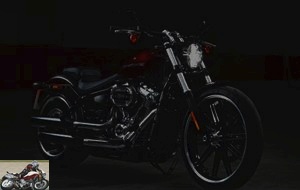
Discovery
Long, low, stocky and slender at the same time: such was the Breakout and still is the Breakout, which already bodes well for answering the crucial question of whether the new one will sell as well as the Ancient. Obviously, it takes a bit of a keen eye to notice that the hunting angle has gone from 37 ° to 34 °, which goes in the direction of greater dynamism. The main thing is that the fundamentals are kept: the well-hollowed saddle, the thin 21-inch front wheel and the large 240 mm wide rear tire, which give it a dragster air and a real posture both in static and on the road. road.
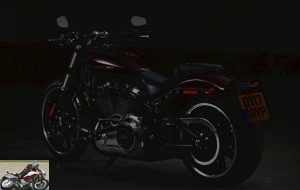
Some proportions have subtly changed: at the level of the tank, now thinner (and with a capacity of 13.2 liters, instead of the previous 18.9 liters). Likewise, the large speedometer which was attached to the handlebars has disappeared, giving way to a small digital element. Finally, the front light uses LEDs: it displays a horizontal bar, which uses the codes of the Livewire electric prototype..
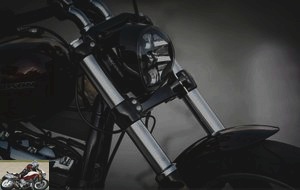
So even though this Breakout is entirely new from floor to ceiling, it retains a nasty style to say the least..
In the saddle
Low, the saddle: with 685 mm, it wants to be accessible to the greatest number. But minute, there! May the gnafrons and other garden gnomes restrain their joy: because the handlebars and the footrests are far ahead and being short on legs will not be enough to integrate you well on this bike. Once in the saddle, we discover the new dashboard, this small digital keypad of mini size, but quite maxi by the amount of information it delivers: tachometer, two trips, clock, range and fuel gauge. Not bad, but a little effort remains to be made for readability in all circumstances.
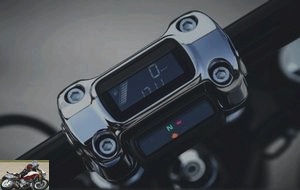
By quibbling a bit, we discover that the headlight cowling, seen from the rear, is a bit plastic with these streaks and cavities: this is necessary for cooling reasons, the LEDs producing a lot of heat..
Engine and transmission
The Milwaukee Eight family has been known since their appearance in the Touring range a year ago, in 2016. It is therefore a latest generation engine, with 4 valves per cylinder and can be matched with several types. cooling. Here, it’s air and oil, with a radiator well integrated in the uprights of the frame at the front. On the Breakout, the customer now has the choice between two possibilities: either the 107 ci (1745 cm3, 86 hp at 5020 rpm, 145 Nm of torque at 3000 rpm), or, as on our test model the 114 ci (1868 cm3, 94 hp at 5020 rpm, 155 Nm at 3000 rpm).
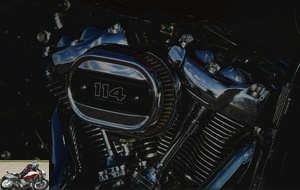
In fact and compared to the 103 ci (1690 cm3) mounted on the previous generation, this additional power translates into better acceleration: 10% gain on 0 to 100 km / h, for the 107 compared to the 103 and still 9% more on the 114 compared to the 107. We will see, however, as this article unfolds, that performance is not everything: the character of these machines has also been profoundly changed..
Moreover, this block is mounted rigid in the frame, but has two balancing pendulums to reduce vibrations..
In the city
Careful, big chunk! With such a wheelbase (1695 mm), do not expect to spin between the lines of cars like Maya the bee at the prospect of finding her friend Willy to go foraging fresh pollen. No, none of that. On the other hand, given the song, we can say that the bike is nevertheless quite stable at low speed and that it is a good quality. On the other hand, for the maneuvers and given the ergonomics of the machine, it will be necessary to be both patient and attentive, given the position of the arms and feet all forward, even if, with the center of gravity all the way down, the weight of the machine (305 kilos, down 16 kilos compared to the previous vintage), not fully felt.
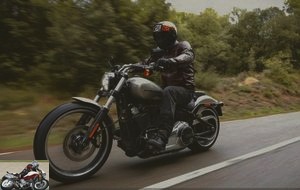
On the engine side, the 114 is generous in piston strokes from the lowest speeds and it will sometimes be necessary to resume the clutch, at low speed, to start again smoothly. On the other hand, on the boulevards, we will cruises at 50 km / h at 2000 rpm in third. If Harley-Davidson has worked, on the generation of Milwaukee Eight, on reducing heat emissions, the rear cylinder still gives off a little at low speed. And let’s not forget that with the low saddle, we find ourselves sitting very close to the catalyst, which heats up to 800 ° C. !
We didn’t do a lot of dense cities on this test (rather small villages in the mountains of the Barcelona region, but the machine seems thin and should go between the lines of cars without too much problem. On the other hand, the tire rear 240 mm will risk to engage a little on the bitumen fittings of the interfile; fortunately, there is no obligation to drive in Paris with !
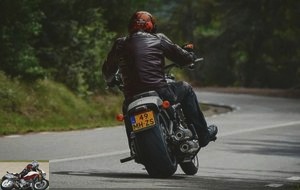
On motorways and main roads
It has reach and resource, this engine. At 130 km / h, we find ourselves at the edge of 3000 rpm in sixth and as much to say that we can devour highways, indefinitely or almost: first because the tank has lost 6 liters compared to the model previous, but also because the driving position lends itself better to more reasonable speeds. Still sitting low enough with a riding position that naturally helps tilt your head forward a bit, which can help fight the elements.
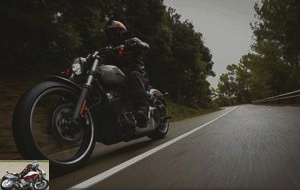
On departmental
"E pure si muove!" said (certainly in another context, good old Galileo). Well it’s a bit the same with the Breakout. Because, from the angle of the very French departmental roads, this chassis borders on heresy: long wheelbase, high weight, very open caster angle, gigantic rear tire and very contrasted with the front, we did better to turn. And yet, it turns, this Breakout. Obviously, we will privilege the exits of curves at the entries, where the ground clearance (26.8 ° on each side) inevitably limits the angle taking: on this test, carried out mainly in the rain, we already put the side stand and the footrests on the ground in the turns (which is the occasion to note that the grip of the Michelin Scorcher, in these dimensions, is downright good in the wet, with a reserve for the white bands where it slips a little, which is not a heresy either when you have 155 Nm of torque to pass).
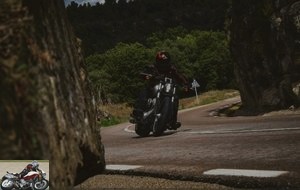
Because this engine sends: finished the nonchalance of the 103, the 114 has the big potato, well supplied from 3000 to 4500 rev / min and responds present when we open the throttle in full. In second, for example, exits from a curve are a bit of a cannonball, since this ratio already allows you to shift beyond 105 km / h in a muffled rumble..
Once the instructions for use are understood, it’s pretty fun to travel as tangent as possible to optimize the cornering, because, all things considered, the machine is finally quite easy to take, even if in the bends very tight, the front axle tends to engage a little. But are the customers of this machine tackling alpine passes? They are probably more likely to stay in the boulevards !
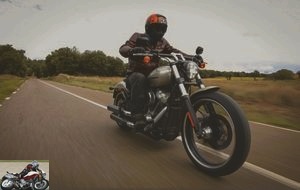
The Breakout has also improved in terms of comfort. Nothing to say about the fork, which does the job in all circumstances while the new rear shock has an easy-to-access preload adjustment, with a thumbwheel on the side. The shock always stays a little dry when rebounding, but works more harmoniously on successions of bumps than in the past.
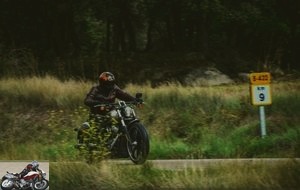
Part-cycle
Everything is new here: the cartridge fork, the rear shock absorber placed in a hinged position between the backbone and the swingarm, which works in compression and which replaces the two shock absorbers placed under the frame of the previous model and which worked in extension. Suffice to say that it is day and night, especially since the frame is 34% more rigid than the previous one..
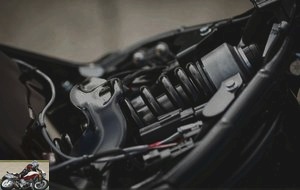
Harley has designed a "modular" frame where, beyond the central element, there are three caster angles (the Breakout has the most open, at 34 °), two triple tree widths (it has the narrow model ) and two swingarm widths (it has the wide version for its 240 rear tire) are offered.
This new configuration made it possible to reduce the weight of 16 kilos compared to the previous vintage..
Brakes
Simple front disc, but 4-piston caliper and fairly transparent ABS: we may have potato, it does the job! In addition, it is dosable and the feedback is good.
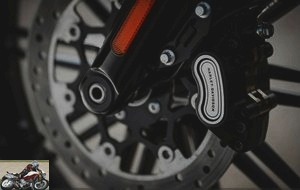
Comfort and duo
The ergonomics are distinctive and necessarily have an impact on comfort, but the saddle is well hollowed out and has not proved to be hard in use; it even makes it possible to stall well during acceleration. The passenger, him, will have to hang on firmly, especially since he will have his knees well bent. A selfish motorcycle, this Breakout ?
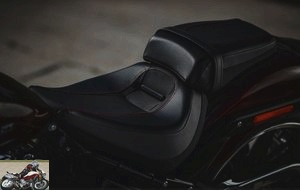
Consumption & autonomy
Backpackers will be unhappy: 6 liters less in the tank on this generation. But do backpackers ride Breakouts? Not so sure. In this case, what matters is that consumption remains contained: Harley-Davidson announces 5.6 l / 100. On our test, the range indicator announced more than 270 kilometers. Not so bad, actually.
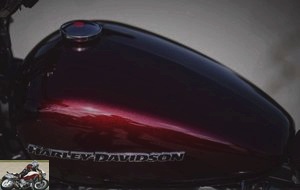
Conclusion
Everything changes, nothing changes? The posture of this bike has remained the same and that is the main thing! An incredible look, an impressive look, further enhanced this year by the LED headlight. Those who loved Breakout have no reason not to love Breakout anymore! And this, especially as the engine deposits even more: a big Harley which extends the arms to the acceleration, it is nevertheless something.
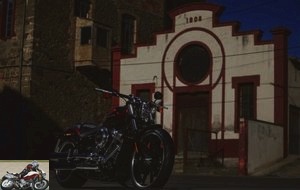
Of course, the chassis has made huge strides as well. The gains in rigidity are real, even if the limited ground clearance reduces the perception. Comfort is also improving, with a rear axle that is less brittle and less rigid than in the past. In short, everything is in place so that the Breakout saga can continue with the same brilliance !
Strong points
- Really punchy engine
- Successful and impactful look
- Driving pleasure
- Improved comfort
- Easily adjustable rear shock
Weak points
- Limited ground clearance, necessarily
- Front axle which engages a little in tight bends
- Ergonomics not for everyone
- Rear cylinder heat rises
The Harley-Davidson Breakout technical sheet
Test conditions
- Itinerary: a big hundred kilometers on mountain roads in the region of Barcelona (Spain), mostly in the rain
- Motorcycle mileage: 500 km
- Problem encountered: The rain sucks. And with a motorcycle like that, it’s 5 hours of cleaning after !
The competition: such a rolling sculpture does not really have any…
Harley-Davidson Breakout video test
Related articles
-
Harley-Davidson Street Bob 107 test
V2, 1745 cm3, 86 hp at 5020 rpm, 145 Nm at 3000 rpm, 297 kilos, from € 14,860 A change in philosophy from the Dyna family to the Softail family It’s been…
-
Harley-Davidson Fat Bob 114 test
V2, 1868 cm3, 94 hp at 5020 rpm, 155 Nm at 3000 rpm, 306 kilos, from € 19,660 Change of style and philosophy for this machine that migrates from the Dyna…
-
Harley-Davidson Ultra Limited Low ‘107’ test
New Milwaukee-Eight engine with 8 valves and mixed air / water cooling for this large road accessible to all 1745 cm3, approx. 90 hp, 152 N.m at 3250…
-
Harley-Davidson Road King Special test
V2, 1745 cm3, approx. 90 hp at 5500 rpm, 150 Nm at 3250 rpm, 355 kilos dry, from € 25,390 The Dark Custom spirit touches the queen of the road Discreet…
-
Harley-Davidson Sport Glide 107 Test
Touring and sport at the same time: absolute versatility according to Harley V2, 1745 cm3, 84 hp at 5400 rpm, 145 Nm at 3250 rpm, 304 dry kilos, from €…
-
Harley-Davidson Forty-Eight and A2 test
1202 cm3, approx. 60 horsepower at 5500 rpm, 96 Nm at 3500 rpm, 252 kilos with full tank, from 12,410 € A minimalist and very stylish machine, generous…
-
Harley-Davidson Road Glide Ultra test
1700 cm3, 80 hp, 138 Nm of torque, cruise control, GPS, audio, € 27,850 A test over almost 4,000 kilometers from Paris to Porto via Wheels Waves and…
-
Harley-Davidson Road Glide CVO 117 test
Welcome to excess Harley-Davidson V2, 1923 cm3, 105 hp at 5450 rpm, 166 Nm at 3500 rpm, 385 kilos dry, from € 41,290 From when, too much is enough? What…
-
Harley-Davidson Freewheeler Test
V2, 1750 cm3, approx. 90 hp, 152 Nm at 3250 rpm, 492 kilos dry, from € 29,850 A stylish and stripped-down three-wheeler to discover the Harley-Davidson…
-
Test: Harley-Davidson Street 750
749 cm3, approx. 57 horses at 7,500 rpm, 59 N.m at 4,000 rpm, 206 kilos dry, from € 6,950 The most accessible way to enter the Harley-Davidson universe…